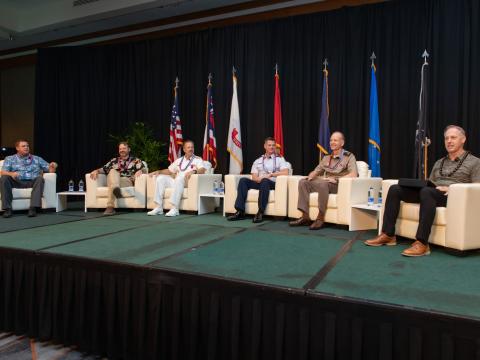Informal, Self-Organizing, Ad Hoc Relational Networks Are the New Multipliers
The advent of social networks is transforming the way the military does business. Net-centric warfare once was in vogue, seeking to capture electrons and raw fiber to transform the way combat was fought. Yet an even more powerful and unanticipated net is making waves in remarkable ways. It is the power of relational networks, fostered by loose ties and catalyzed by the proliferation of quickly evolving online platforms.
These networks of individuals are as far removed from centralized chains of command as anyone can be. They span ranks, ages, services and communities. As with water running down a rocky mountain, they find a way to interact and build each other’s knowledge base no matter the formal obstacles laid down by bureaucracy.
The power of these relationships was made very real to me last year when I joined Twitter. Randomly following military-related users, I soon became engaged in deeply strategic conversations with people I never would have found on my own. Senior Army officers were engaging informally with enlisted sailors and deployed Air Force pilots, sparring and parrying with a flurry of articles, links and philosophical references. Nobody told these folks to work together—they simply assembled on their own.
It became apparent that not only were these self-organizing and ever-evolving groups of people learning about warfare in a totally new way, they were becoming friends. Service members continents apart from each other, never having met, now had groups of peers and friends to have a beer with while on temporary assigned duty or leave. Their virtual conversations turned into very real, face-to-face interactions.
The current generation of military officers and enlisted personnel communicate very differently than those born even just 10 years prior to them. It can be overwhelming at times, but digital natives have a way of managing and gliding between formal and informal interactions with great ease. Social networks by their very nature break down barriers, foster collaboration and introduce the power of serendipity.
These informal networks also have another effect—they expose their adherents to a wide variety of professions and viewpoints. The 21st century will be shaped by people who can meld various fields together to find previously unknown synergies. Loose ties, and the intellectual curiosity that binds them, provide the catalyst for these advances.
Lessons learned in the chaos of Iraq and Afghanistan mirror this relational networking model. A generation of junior leaders, both officer and enlisted, raised in the midst of a counterinsurgency, have had to rely on nontraditional hierarchies to get things done. Success in rebuilding war-torn villages often was created by those who could link clerics, local shop owners and politicians in useful, unscripted coalitions. Melding disparate interests and individuals—rather than sticking strictly to vertical command and control military models—was a recipe for progress.
The lesson is that military innovation and creativity often are cultivated outside of directed hierarchical channels. The formation of the Defense Entrepreneurs Forum is a case in point. A group of junior officers from across the services wanted to bring their innovative compatriots together, so they created a unique conference dedicated to moving the military forward by solving problems through techniques learned at startup weekend events. No one told them to do it; they simply executed, and although many of them have never met, they are organizing this conference exclusively through various online portals.
Defined chains of command and vertical structures will, and must, always remain an integral element of combat operations. But senior leaders and decision makers must understand the influence of less tightly integrated collaborative structures if they want to get the most out of emerging military leaders.
“Know your people” has been an adage of top-flight leaders for millennia—and the current generation of millennials are by their very nature entrepreneurial, collaborative and willing to create ad hoc networks outside traditional channels to get things done. Harnessing these energies can lead to incredible results.
This is especially important as we enter an interwar period. Past consolidations have rewarded those able to navigate the bureaucracy, but we cannot afford a similar approach this time around. Even though the services are consolidating, now is the perfect time to take risks and explore new models for discovering creative tactical and policy solutions. The cost of failure in garrison is small, while the upside to discovering disruptive solutions to unknown problems potentially is immense.
Senior leaders would be wise to continue to encourage the formation of ad hoc collaborative and self-organizing relational networks. It’s time we recognize that network effects apply to more than just electrons, and instead that their greatest value lies in the minds of those making widespread relational connections.
Lt. Ben Kohlmann, USN, is an F/A-18 instructor pilot serving in the Innovation and Concepts Department at the Naval Warfare Development Command, part of the Chief of Naval Operations’ Rapid Innovation Cell. He is the founder of Disruptive Thinkers, an organization devoted to bringing innovative military personnel together with civilian entrepreneurs. The views expressed in this column are his own and not necessarily those of the U.S. Navy or of SIGNAL Magazine. We welcome your comments on this column below or via email at signalnews@afcea.org.


Comments